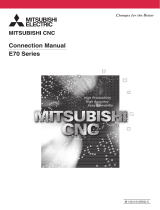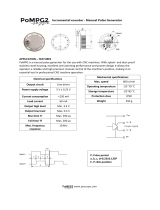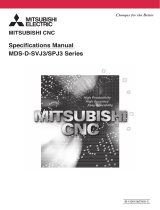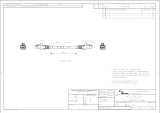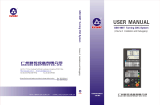Page is loading ...



Introduction
This manual covers the items required for installing and connecting the MITSUBISHI CNC 70 Series.
Read this manual thoroughly and understand the product's functions and performance before starting to
use.
This manual is written on the assumption that all option functions are added, but the actually delivered
device may not have all functions.
The unit names, cable names and various specifications are subject to change without notice. Please
confirm these before placing an order.
For items described as "Restrictions" or "Usable State" in this manual, the instruction manual issued by
the machine tool builder takes precedence over this manual.
Items that are not described in this manual must be interpreted as "not possible".
This manual is written on the assumption that all option functions are added. Confirm the specifications
issued by the machine tool builder before use.
Refer to the Instruction Manual issued by each machine tool builder for details on each machine tool.
Some screens and functions may differ depending on each NC system (or version), and some functions
may not be possible. Please confirm the specifications before use.
The numerical control unit is configured of the control unit, display unit, operation board, servo drive
unit, spindle drive unit, power supply unit + driver, servomotor, and spindle motor, etc.
In this manual, the following items are generically called the "controller".
- Control unit
- Display unit
- Operation board
- Numerical control unit peripheral devices (input/output unit, safety unit)
In this manual, the following items are generically called the "drive unit".
- Servo drive unit
- Spindle drive unit
- Power supply unit + driver
In this manual, the following items are generically called the "motor".
- Servo motor
- Spindle motor
CAUTION


Precautions for Safety
Always read this manual and enclosed documents before installation, operation, maintenance and
inspection to ensure correct usage. Thoroughly understand the basics, safety information and
precautions of the devices before using.
This manual classifies the safety precautions into "DANGER", "WARNING" and "CAUTION".
Note that the items under " CAUTION" could lead to serious consequences as well depending on the
situation. Please follow all items listed in "Precautions for Safety" as they are equally important.
When the user could be subject to imminent fatalities or serious injuries if handling is mistaken.
When the user could be subject to fatalities or serious injuries if handling is mistaken.
When the user could be subject to minor or moderate injuries or the property could be damaged if
handling is mistaken.
DANGER
WARNING
CAUTION

This product is not designed or manufactured on the assumption that the product will be used for the
equipment or systems that are to be subject to any fatal consequences. Please inquire our customer
service department about any particular usage other than the normal usage as a machine tool.
1. Items related to prevention of electric shocks
2. Items related to prevention of fire
For Safe Use
Do not open or remove the front cover while the power is ON or during operation. The high voltage termi-
nals and charged sections will be exposed, and this could result in electric shocks.
Do not remove the front cover even when the power is OFF, except for the wiring works or periodic in-
spections. The inside of the controller and drive unit are charged, and this could result in electric shocks.
Always wait at least 15 minutes after turning the power OFF. Then, check the voltage with a tester, etc.,
before wiring works, inspections or connecting with peripheral devices. Failure to observe this could re-
sult in electric shocks.
Earth ground the controller, drive unit and motor according to the local laws. (In Japan, ground the 200V
Series input products with Class C or higher protective grounding and the 400V Series input with Class
D or higher protective grounding.)
All wiring works, maintenance and inspections must be carried out by a qualified technician. Failure to
observe this could result in electric shocks. Contact your nearby Service Center or Service Station for
replacing parts and servicing.
Wire the controller, drive unit and motor after installation. Failure to observe this could result in electric
shocks.
Do not operate the switches with wet hands. Failure to observe this could result in electric shocks.
Do not damage, apply excessive stress, place heavy things on or sandwich the cables. Failure to observe
this could result in electric shocks.
Insulate the power lead using a fixed terminal block. Failure to observe this could result in electric shocks.
Install the controller, drive unit, motor and regenerative resistor on non-combustible material. Installation
directly on or near combustible materials could result in fires.
If any malfunction in the unit is observed, shut off the power at the unit’s power supply side. Continuous
flow of large current could result in fires.
Install an appropriate no fuse breaker (NFB) and contactor (MC) on the power input section of the drive
unit and configure the sequence that shuts the power off upon drive unit’s emergency stop or alarm.
When a breaker is shared for multiple power supply units, the breaker may not function upon short-circuit
failure in a small capacity unit. Do not share a breaker for multiple units as this is dangerous.
Incorrect wiring and connections could cause the devices to damage or burn.
WARNING
CAUTION

3. Items related to prevention of bodily injury or property damage
4. General precautions
Always follow the precautions below. Incorrect handling could result in faults, injuries or electric shocks, etc.
(1) Transportation and installation
When transporting or installing a built-in IPM spindle or linear servomotor, be careful so that your hand
or property will not be trapped in the motors or other metal objects. Also keep the devices with low mag-
netic tolerance away from the product.
Do not apply voltages to the connectors or terminals other than voltages indicated in the connection man-
ual for the controller or specifications manual for the drive unit. Failure to observe this could cause burst-
ing, damage, etc.
Incorrect connections could cause the devices to rupture or damage, etc. Always connect the cables to
the indicated connectors or terminals.
Incorrect polarity (+ -) could cause the devices to rupture or damage, etc.
Persons wearing medical devices, such as pacemakers, must stay away from this unit. The electromag-
netic waves could adversely affect the medical devices.
Fins on the rear of the unit, regenerative resistor and motor, etc., will be hot during operation and for a
while after the power has been turned OFF. Do not touch or place the parts and cables, etc. close to these
sections. Failure to observe this could result in burns.
Do not enter the machine’s movable range during automatic operation. Keep your hands, feet or face
away from the spindle during rotation.
Correctly transport the products according to the mass.
Use motor’s suspension bolts to transport the motor itself. Do not use it to transport the motor after in-
stallation onto the machine.
Do not stack the products exceeding the indicated limit.
Do not hold the cables, shaft or detector when transporting the motor.
Do not transport the controller or drive unit by suspending or holding the connected wires or cables.
Do not hold the front cover when transporting the unit, or the front cover could come off, causing the unit
to drop.
Install on a non-combustible place where the unit’s or motor’s mass can be withstood according to the
instruction manual.
The motor does not have a complete water-proof (oil-proof) structure. Do not allow oil or water to contact
or enter the motor. Prevent the cutting chips from being accumulated on the motor as they easily soak up
oil.
When installing the motor facing upwards, take measures on the machine side so that gear oil, etc., will
not enter the motor shaft.
Do not remove the detector from the motor. (The detector installation screw is treated with sealing.)
DANGER
CAUTION
CAUTION

(2) Items related to wiring
Do not allow foreign matters, especially, conductive foreign matters such as screws or metal chips, or
combustible foreign matters such as oil, to enter the controller, drive unit or motor. Failure to observe this
could result in rupture or damage.
Do not get on the product or place heavy objects on it.
Provide prescribed distance between the controller/drive unit and inner surface of the control panel/other
devices.
Do not install or operate the controller, drive unit or motor that is damaged or has missing parts.
Take care not to cut hands, etc. with the heat radiating fins or metal edges.
Do not block the intake/outtake ports of the motor with the cooling fan.
Install the controller’s display section and operation board section on the spot where cutting oil will not
reach.
The controller, drive unit and motor are precision devices, so do not drop or apply thumping vibration and
strong impacts on them.
Hard disk unit is a precision device, so do not drop or apply strong impacts on it.
Store and use the units according to the environment conditions indicated in each specifications manual.
Securely fix the motor to the machine. The motor could come off during operation if insecurely fixed.
Always install the motor with reduction gear in the designated direction. Failure to observe this could re-
sult in oil leaks.
Always install a cover, etc., over the shaft so that the rotary section of the motor cannot be touched during
motor rotation.
When installing a coupling to the servomotor shaft end, do not apply impacts by hammering, etc. The de-
tector could be damaged.
Use a flexible coupling when connecting with a ball screw, etc., and keep the shaft core deviation smaller
than the tolerable radial load of the shaft.
Do not use a rigid coupling as an excessive bending load will be applied on the shaft and could cause the
shaft to break.
Do not apply a load exceeding the tolerable level onto the motor shaft. The shaft or bearing could be dam-
aged.
Before using this product after a long period of storage, please contact the Mitsubishi Service Station or
Service Center.
Following the UN recommendations, battery units and batteries should be transported based on the inter-
national regulations such as those determined by International Civil Aviation Organization (ICAO), Inter-
national Air Transport Association (IATA), International Maritime Organization (IMO) and U.S. Department
of Transportation (DOT).
Correctly wire this product. Failure to observe this could result in motor runaway, etc.
Do not install a phase advancing capacitor, surge absorber or radio noise filter on the output side of the
drive unit.
Correctly connect the output side (terminal U, V, W). The motor will not run properly if incorrectly connect-
ed.
Always install an AC reactor per each power supply unit.
Always install an appropriate breaker per each power supply unit. A breaker cannot be shared for multiple
power supply units.
CAUTION
CAUTION

(3) Adjustments
Do not directly connect a commercial power supply to the motor. Failure to observe this could result in
faults.
When using an inductive load such as relays, always connect a diode in parallel to the load as a noise
countermeasure.
When using a capacitive load such as a lamp, always connect a protective resistor serially to the load to
suppress rush currents.
Do not mistake the direction of the surge absorption diode to be installed on the DC relay for the control
output signal. If mistaken, the signal will not be output due to fault in the drive unit, and consequently the
protective circuit, such as emergency stop, could be disabled.
Do not connect or disconnect the connection cables between each unit while the power is ON.
Do not connect or disconnect the PCBs while the power is ON.
Do not pull the cables when connecting/disconnecting it.
Securely tighten the cable connector fixing screw or fixing mechanism. The motor could come off during
operation if insecurely fixed.
Always treat the shield cables indicated in the Connection Manual with grounding measures such as cable
clamps.
Separate the signal wire from the drive line or power line when wiring.
Use wires and cables whose wire diameter, heat resistance level and bending capacity are compatible with
the system.
Ground the device according to the requirements of the country where the device is to be used.
Wire the heat radiating fins and wires so that they do not contact.
When using the RS-232C device as a peripheral device, caution must be paid for connector connection/
disconnection. Always use a double-OFF type AC power supply switch on the device side, and connect/
disconnect the connector with the AC power supply on the device side OFF.
Check and adjust programs and each parameter before starting operation. Failure to observe this could
result in unpredictable operations depending on the machine.
Do not make drastic adjustments or changes as the operation could become unstable.
CAUTION
R
A
RA
COM
(24VDC)
Control
output
signal
Servo drive unit
COM
(24VDC)
Servo drive unit
Control
output
signal
NC
unit
Device
Switch
A
C socket
RS-232C
CAUTION

(4) Usage
(5) Troubleshooting
Install an external emergency stop circuit so that the operation can be stopped and the power turns OFF
immediately when unforeseen situation occurs. A contactor, etc., is required in addition to the shutoff
function mounted in the controller.
Turn OFF the power immediately if any smoke, abnormal noise or odor is generated from the controller,
drive unit or motor.
Only a qualified technician may disassemble or repair this product.
Do not alter.
Use a noise filter, etc. to reduce the effect of electromagnetic disturbances in the case where electromag-
netic disturbances could adversely affect the electronic devices used near the drive unit.
Use the drive unit, motor and each regenerative resistor with the designated combination. Failure to ob-
serve this could result in fires or faults.
The combination of the motor and drive unit that can be used is determined. Be sure to check the models
of motor and drive unit before test operation.
The brakes (electromagnetic brakes) mounted in the servomotor are used for the purpose of holding, and
must not be used for normal braking. Also, do not run the motor with the motor brake applied. Motor brake
is used for the purpose of holding.
For the system running via a timing belt, install a brake on the machine side so that safety can be ensured.
Be sure to confirm SERVO OFF (or READY OFF) when applying the electromagnetic brake. Also, be sure
to confirm SERVO ON prior to releasing the brake.
When using the DC OFF type electromagnetic brake, be sure to install a surge absorber on the brake ter-
minal.
Do not connect or disconnect the cannon plug while the electromagnetic brake’s power is ON. The can-
non plug pins could be damaged by sparks.
After changing programs/parameters, or after maintenance/inspection, always carry out a test operation
before starting actual operation.
Use the power that are complied with the power specification conditions (input voltage, input frequency,
tolerable instantaneous power failure time) indicated in each specifications manual.
When making detector cables, do not mistake connection. Failure to observe this could result in malfunc-
tion, runaway or fire.
Use a motor with electromagnetic brakes
or establish an external brake mechanism
for the purpose of holding; this serves as
countermeasures for possible hazardous
situation caused by power failure or prod-
uct fault.
Use a double circuit structure for the elec-
tromagnetic brake’s operation circuit so
that the brakes will activate even when the
external emergency stop signal is issued.
CAUTION
CAUTION
Servomoto
r
Electro-
magnetic
brake
Shut off with motor
brake control output
Shut off with CNC
brake control PLC
output
MBR
EMG
24VDC

(6) Maintenance, inspection and part replacement
(7) Disposal
(8) General precautions
The machine could suddenly restart when the power is restored after an instantaneous power failure, so
stay away from the machine. (Design the machine so that the operator safety can be ensured even if the
machine restarts.)
To secure the absolute position, do not shut off the servo drive unit’s control power supply when its bat-
tery voltage drops (warning 9F) in the servo drive unit side.
If the battery voltage drop warning alarm occurs in the controller side, make sure to back up the machin-
ing programs, tool data and parameters, etc. with the input/output device before replacing the battery. De-
pending on the level of voltage drop, memory loss could have happened. In that case, reload all the data
backed up before the alarm occurrence.
Periodically back up the programs, tool data and parameters to avoid potential data loss. Also, back up
those data before maintenance and inspections.
When replacing the battery on the controller side, the machining programs, tool data and parameters
should be backed up with the input/output device beforehand. In case the memory is damaged in replac-
ing the batteries, reload all the data backed up before replacing the battery.
The electrolytic capacitor’s capacity will drop due to deterioration. To prevent secondary damage due to
capacitor’s faults, Mitsubishi recommends the electrolytic capacitor to be replaced approx. every five
years even when used in a normal environment. Contact the Service Center or Service Station for replace-
ments.
Do not perform a megger test (insulation resistance measurement) during inspection.
Do not replace parts or devices while the power is ON.
Do not short-circuit, charge, overheat, incinerate or disassemble the battery.
There may be a unit filled with substitute Freon in the heat radiating fins of the 37kW or smaller unit. Be
careful not to break the heat radiating fins during maintenance or replacement.
Take the batteries and backlights for LCD, etc., off from the controller, drive unit and motor, and dispose
of them as general industrial wastes.
Do not alter or disassemble controller, drive unit, or motor.
Collect and dispose of the spent batteries and the backlights for LCD according to the local laws.
To explain the details, drawings given in the instruction manual, etc., may show the unit with the cover or safety
partition removed. When operating the product, always place the cover or partitions back to their original position,
and operate as indicated in the instruction manual, etc.
CAUTION
CAUTION
CAUTION


Disposal
(Note) This symbol mark is for EU countries only.
This symbol mark is according to the directive 2006/66/EC Article 20 Information for end-
users and Annex II.
Your MITSUBISHI ELECTRIC product is designed and manufactured with high quality materials and
components which can be recycled and/or reused.
This symbol means that batteries and accumulators, at their end-of-life, should be disposed of
separately from your household waste.
If a chemical symbol is printed beneath the symbol shown above, this chemical symbol means that the
battery or accumulator contains a heavy metal at a certain concentration. This will be indicated as
follows:
Hg: mercury (0,0005%), Cd: cadmium (0,002%), Pb: lead (0,004%)
In the European Union there are separate collection systems for used batteries and accumulators.
Please, dispose of batteries and accumulators correctly at your local community waste collection/
recycling centre.
Please, help us to conserve the environment we live in!


Contents
1. System Configuration....................................................1
1.1 System Basic Configuration Drawing.........................................................................2
1.2 General Connection Diagram.....................................................................................3
1.2.1 Without Touch Panel...........................................................................................3
1.2.2 With Touch Panel................................................................................................4
1.3 List of Units and Cables .............................................................................................5
1.3.1 List of Units.........................................................................................................5
1.3.2 Durable Parts......................................................................................................7
1.3.3 Replacements.....................................................................................................7
1.3.4 List of Cables......................................................................................................8
2. General Specifications ................................................11
2.1 Environment Conditions...........................................................................................12
2.2 Control Unit..............................................................................................................14
2.3 Display Unit..............................................................................................................24
2.4 Keyboard Unit ..........................................................................................................27
2.5 Operation Panel I/O Unit..........................................................................................32
2.6 Remote I/O Unit .......................................................................................................43
2.7 Scan I/O Unit............................................................................................................49
2.8 External Power Supply Unit .....................................................................................60
2.9 Manual Pulse Generator..........................................................................................63
2.10 Synchronous Feed Encoder...................................................................................65
2.11 Precautions for Use of Commercially Available CF Cards.....................................66
3. Installation....................................................................67
3.1 Heat Radiation Countermeasures............................................................................68
3.2 Noise Countermeasures ..........................................................................................71
3.2.1 Connection of FG (Frame Ground)...................................................................71
3.2.2 Shield Clamping of Cables................................................................................72
3.2.3 Connecting Spark Killers...................................................................................72
3.3 Unit Installation.........................................................................................................73
3.3.1 Display unit .......................................................................................................73
3.3.2 Keyboard Unit...................................................................................................74
3.3.3 Operation Panel I/O Unit...................................................................................74
3.3.4 Control Unit Battery...........................................................................................75
4. Connection ...................................................................77
4.1 Precautions for Wiring..............................................................................................78
4.1.1 Precautions when Connecting/Disconnecting Cables ......................................78
4.1.2 Precautions for Using Optical Communication Cable.......................................81
4.1.2.1 Optical Communication Cable Outline and Parts ......................................81
4.1.2.2 Precautions for Handling Optical Communication Cable...........................81
4.1.2.3 Precautions for Laying Optical Communication Cable ..............................82
4.1.3 Precautions for Connecting 24V Power Supply................................................82

4.2 Connection of Control Unit .......................................................................................83
4.2.1 Control Unit Connection System Drawing.........................................................83
4.2.2 Connecting with Power Supply .........................................................................84
4.2.3 Connecting with Emergency Stop Signal..........................................................85
4.2.4 Connecting with Operation Panel I/O Unit ........................................................87
4.2.5 Connecting with Servo Drive Unit .....................................................................88
4.2.5.1 Connecting with MDS-D/DH Series...........................................................89
4.2.5.2 Connecting with MDS-DM Series ..............................................................92
4.2.5.3 Connecting with MDS-SVJ3/SPJ3 Series..................................................97
4.2.6 Connecting I/O Devices via CC-Link.................................................................98
4.2.7 Connecting with RS-232C Device...................................................................100
4.2.8 Connecting with Skip Signal (Sensor).............................................................102
4.2.9 Connecting with Synchronous Feed Encoder/ Manual Pulse Generator........104
4.3 Connection of Operation Panel I/O Unit.................................................................105
4.3.1 Operation Panel I/O Unit Connection System Drawing...................................105
4.3.2 Connecting with Keyboard Unit.......................................................................106
4.3.3 Connecting with Manual Pulse Generator (MPG)...........................................107
4.3.4 Connecting with Machine Operation Panel.....................................................108
4.3.4.1 Wiring for Sink Type Output (FCU7-DX710/DX720/DX730)....................109
4.3.4.2 Wiring for Source Type Output (FCU7-DX711/DX721/DX731) ...............110
4.3.4.3 Outline of Analog Signal Output Circuit ...................................................111
4.4 Connection of Remote I/O Unit...............................................................................112
4.4.1 Connection and Station No. Setting on Remote I/O Unit ................................112
4.4.2 Station No. Setting when Using Multiple Remote I/O Units ............................114
4.4.3 Connecting FCUA-DX10*/14* Unit with Machine Control Signal ....................118
4.4.4 Connecting FCUA-DX14* Unit with Analog Input/Output Signal.....................120
4.4.5 Connecting FCUA-DX11* Unit with Machine Control Signal...........................121
4.4.6 Connecting FCUA-DX12* Unit with Machine Control Signal...........................123
4.5 Connection of Scan I/O card ..................................................................................125
5. EMC Installation Guidelines...................................... 127
5.1 Introduction.............................................................................................................128
5.2 EMC Directives.......................................................................................................128
5.3 EMC Measures.......................................................................................................129
5.4 Panel Structure.......................................................................................................129
5.4.1 Measures for Control Panel Body ...................................................................129
5.4.2 Measures for Door ..........................................................................................130
5.4.3 Measures for Power Supply............................................................................130
5.5 Measures for Wiring in Panel .................................................................................131
5.5.1 Precautions for Wiring in Panel.......................................................................131
5.5.2 Shield Treatment of Cables.............................................................................132
5.6 EMC Countermeasure Parts ..................................................................................134
5.6.1 Shield Clamp Fitting........................................................................................134
5.6.2 Ferrite Core.....................................................................................................135
5.6.3 Surge Absorber...............................................................................................136
5.6.4 Selection of Stabilized Power Supply..............................................................138
6. Transportation Restrictions for Lithium Batteries.. 139
6.1 Restriction for Packing............................................................................................140

6.1.1 Target Products ..............................................................................................141
6.1.2 Handling by User ............................................................................................142
6.1.3 Reference .......................................................................................................143
6.2 Issuing Domestic Law of the United States
for Primary Lithium Battery Transportation.....................................144
6.2.1 Outline of Regulation ......................................................................................144
6.2.2 Target Products ..............................................................................................144
6.2.3 Handling by User ............................................................................................144
6.2.4 Reference .......................................................................................................144
6.3 Example of Hazardous Goods Declaration List .....................................................145
7. Precautions for Compliance to UL/c-UL Standards 147
8. Cable ........................................................................... 149
8.1 Cable Wire and Assembly......................................................................................150
8.2 CNP2E-1 Cable......................................................................................................152
8.3 CNV2E-6P/CNV2E-7P Cable.................................................................................153
8.4 CNV2E-8P/CNV2E-9P Cable.................................................................................154
8.5 CNV2E-D Cable.....................................................................................................155
8.6 CNV2E-HP Cable...................................................................................................156
8.7 DG21 Cable ...........................................................................................................157
8.8 DG22 Cable ...........................................................................................................158
8.9 F023/F024 Cable ...................................................................................................159
8.10 F034/F035 Cable .................................................................................................160
8.11 F070 Cable...........................................................................................................161
8.12 F110 Cable...........................................................................................................162
8.13 F120 Cable...........................................................................................................163
8.14 F170 Cable...........................................................................................................164
8.15 F221 Cable...........................................................................................................165
8.16 F320/F321 Cable .................................................................................................166
8.17 F
351 Cable...........................................................................................................167
8.18 FCUA-R030 Cable ...............................................................................................168
8.19 FCUA-R031 Cable ...............................................................................................169
8.20 FCUA-R050/R054 Cable......................................................................................170
8.21 FCUA-R211 Cable ...............................................................................................171
8.22 FCUA-R300/FCUA-R301 Cable...........................................................................172
8.23 G011 Cable..........................................................................................................174
8.24 G023/G024 Cable................................................................................................175
8.25 G300 Cable..........................................................................................................176
8.26 G301 Cable..........................................................................................................177
8.27 G380 Cable..........................................................................................................178
8.28 G395 Cable..........................................................................................................179
8.29 G396 Cable..........................................................................................................180
8.30 R-TM Terminator Connector ................................................................................181
8.31 SH21 Cable..........................................................................................................182
8.32 SH41 Cable..........................................................................................................183
8.33 List of Cable Connector Sets ...............................................................................184


1
1
1
System Configuration

1 System Configuration
MITSUBISHI CNC
2
1.1 System Basic Configuration Drawing
(Note 1) Control unit is mounted on the back side of the display unit.
(Note 2) Operation panel I/O unit is mounted on the back side of the keyboard unit.
MF M CODE DATA
TF T CODE DATA
AL1 AL2 AL3 AL4 TA P DEN OP SA MA
SF LED29 LED30 LED31 LED32 LED33LED34 LED35 LED36
MANUA L FEED RATE
SW1 SW9 SW10 SW11 SW12 SW13 OV SL OV C SRN F1DSW8SW7SW6SW5SW4SW3SW2
DRY RUN
FIN
OFF
ON
MST LOCK
SINGLE BLOCK
RESET
MACHINE LOCK
+X +4+Z+Y
-X -4-Z-Y FEED HOLDCYCLE START
EMERGENCY STOP
DEGITAL SWITCH
4ZYX
1ST REFERENCE POSITI ON
REACHED
CUTTING FEEDRATE OVERRI DEMODE SELECTHANDLE/STEP MULTIPLI C ATI ON
100000
1
10
100
1000
5000
10000
50000
-+
TAPE
STEP
RAPID
JOG
MEM
MDI
R-POINT RETURN
Y
X
4
Z
HANDLE
RAPID TRAVERSE OVERRI DE
1
25
50
100
180
40
60
80
100
120
140
160
90
70
50
30
20
10
0
%
110
130
150
170
190
200
7200
20
52
200
520
1000
2000
3700
270
100
27
10
2
1
0
mm/min
720
1400
2700
5200
10000
14000
Display unit
Keyboard unit
CompactFlash card
Emergency
stop switch
Operation panel
I/O unit
Control unit
Manual pulse
generator
Machine operation panel
Servo/Spindle drive units
Motors
MDS-D/DH Series
MDS-D-SVJ3/SPJ3 Series
MDS-DM Series
Synchronous feed
encoder
Remote I/O
unit
Manual pulse
generator
Skip
Ethernet hub
Personal
computer
/
